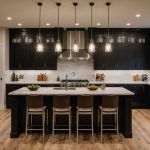Understanding Adjustable Track Lighting
Adjustable track lighting offers a flexible and practical solution for modern kitchen lighting needs. Unlike traditional fixtures, adjustable track lighting allows for the direction and focus of light to be changed, enabling homeowners to tailor their kitchen lighting to meet specific needs. This feature enhances functionality and aesthetics, making it a popular choice among kitchen lighting solutions.
One of the key benefits of this type of lighting system is its versatility. It provides a sophisticated method to illuminate different kitchen zones, ensuring optimal brightness for activities such as cooking and dining. With lighting design, one can creatively highlight architectural features or create ambient mood lighting by simply adjusting the fixture’s direction.
In parallel : Maximizing Kitchen Enjoyment: How Cooktop and Oven Placement Influences Ergonomics and Promotes Healthier Eating
When comparing track lighting to other options, such as pendant or recessed lighting, track systems stand out for their adaptability in homes with changing spatial or decorative needs. Pendant lights might offer a stronger aesthetic punch, and recessed lighting provides a clean, integrated look; however, adjustable track lighting combines practicality and design flexibility in one package. It’s an excellent choice for those seeking a kitchen lighting solution that evolves with interior design changes or personal preferences.
Enhancing Meal Presentation with Lighting
In culinary settings, lighting is crucial for meal presentation and enhancing the visual appeal. It plays a vital role not only in preparing food but also in how it is served and perceived. Photographers often emphasize the importance of lighting in framing and food photography. Proper illumination highlights colours, textures, and freshness, making dishes look more enticing.
Also to see : Revamp Your Culinary Space: Elevate Self-Awareness and Nutrition with a Full-Length Mirror
Importance of Lighting in Culinary Presentation
The right lighting can elevate the dining experience by accentuating the aesthetics of a dish. Dull lighting might render a meal less appealing, impacting the diner’s first impression. Bright, evenly distributed light can make meals look fresh and vibrant.
Color Temperature and Its Impact on Food Appearance
Color temperature significantly affects how food is visually perceived. Warm lighting typically enhances reds and yellows, ideal for enhancing the appeal of meats and autumnal dishes. Conversely, cooler tones can make fresh produce and greens appear crisp and lively. Understanding these effects allows chefs to choose the right lighting to enhance their creations.
Strategic Placement of Lights for Optimal Effects
Strategic placement of lighting elements is essential. Shadows can be used to create depth and interest, though excessive shadowing can detract from the dish. Restaurants often implement case studies to determine optimal positioning, ensuring the light complements the presentation without overpowering it.
Impact of Lighting on Portion Control
Lighting plays a surprisingly significant role in portion control by altering the perception of portion sizes. Studies show that dim lighting can lead to larger servings, as it creates a cozy, relaxed environment where diners feel uninhibited. The psychological effects of lighting extend to appetite regulation, with bright lights often promoting alertness, leading to more mindful eating. These effects are backed by insights from lighting experts who suggest that strategic lighting can indeed aid in better portion regulation during meals.
In terms of the dining experience, lighting influences serving choices. For instance, softer, ambient lighting may encourage diners to indulge more, as they feel comforted, whereas sharper lighting might make portion sizes appear more prominent, nudging diners towards smaller servings. Adjusting lighting balance in dining spaces can thus create an atmosphere that complements nutritional goals.
Expert insights reveal that incorporating adjustable lighting into dining settings allows for flexibility. By modifying both intensity and colour temperature, one can subtly facilitate a more controlled dining environment, assisting with portion awareness while enhancing the overall dining experience. This thoughtful approach aligns with broader kitchen lighting design principles.
Understanding Adjustable Track Lighting
Adjustable track lighting brings versatility to kitchen lighting solutions, making it an attractive option for modern homes. This type of lighting stands out due to its ability to adjust the direction and focus of light, which means that the illumination can be easily tailored to suit specific tasks or ambiance requirements. It adds a layer of flexibility that traditional fixtures lack, as these are generally more static in their application.
When installed in a kitchen, adjustable track lighting can distinctly enhance the space. It allows you to spotlight different areas, such as the cooking zone or dining nook, creating ideal conditions for every activity. Moreover, the stylish and sleek design integrates well with contemporary or minimalist themes, ensuring that lighting design forms a part of the overall aesthetic.
In comparison to other systems, adjustable track lighting offers a unique blend of function and form. Unlike pendant lights, which provide localized illumination, or recessed lighting that offers a uniform glow, track systems provide flexibility. It lets users make on-the-fly adjustments based on their current needs without significant changes to the setup, offering a practical and adaptable solution for evolving interiors.
Practical Tips for Installing Adjustable Track Lighting
For those diving into the world of DIY lighting, installation tips can ease the process of setting up adjustable track lighting. Properly installing track lighting begins with understanding the required tools and materials. Basic essentials include a voltage tester, a drill, and insulated screwdrivers. Safety first: always turn off power via the circuit breaker.
Tools and Materials Needed for Installation
Before installation, gather necessary supplies:
- Voltage tester to ensure no live wires
- Drill and drill bits for mounting tracks
- Wire connectors for secure electrical connections
Ensuring that you have these tools at hand will prevent mid-project interruptions.
Steps to Properly Install Track Lighting
Start with marking the lighting track position, aligning it with the kitchen layout. Drill holes for mounting anchors. The next step is wiring. Carefully connect wires from the ceiling to the track and secure them using wire connectors. Once fixed, set the fixtures in position.
Common Mistakes to Avoid During Installation
Be aware to avoid common errors like improper alignment, which can lead to ineffective lighting. Adjust angles for optimal effect: a slight tilt can drastically change light focus. Regularly check tool functionality for smooth installation and always ensure safety by double-checking electrical setups.











